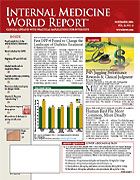Publication
Article
Internal Medicine World Report
Polycystic Ovarian Syndrome: New Clinical Clues to a Common Condition
Author(s):
Polycystic ovarian syndrome (PCOS) affects almost 4 million US women, or 5% to 10% of those of reproductive age, making it the most common endocrine-related condition in reproductive-aged women, according to the Endocrine Society. Annual healthcare-related costs are $4.36 billion, with $1.77 billion spent on treating associated diabetes and $1.35 billion on treating menstrual dysfunction.
The diagnosis of PCOS implies that a woman is at increased risk for infertility, dysfunctional bleeding, endometrial carcinoma, obesity, type 2 diabetes, dyslipidemia, hypertension, and possibly cardiovascular disease, and that her sisters, daughters, and other close female relatives may also be at risk. She may require lifelong therapy and find that her access to healthcare coverage is limited.
Despite the commonality of the condition and the ramifications of a diagnosis, no clear-cut definition of PCOS has been established. A Task Force appointed by the Androgen Excess Society has now reviewed all available data and recommended a new evidence-based definition (J Clin Endocrinol Metab. 2006 Aug 29.).
The Task Force identified 4 key clinical features of PCOS:
• Ovulatory and menstrual dysfunction: 75% of patients have clinically evident menstrual dysfunction, and 20% have a history of apparent eumenorrhea. In women with hirsutism and eumenorrhea, anovulation can be confirmed by measuring serum progesterone during days 20 through 24 of the cycle.
• Hyperandrogenemia: 60% to 80% of patients have increased circulating androgen levels, primarily free testosterone. This cannot be the sole diagnostic criterion, because 20% to 40% of patients with PCOS have normal androgen levels, and assays are notoriously inaccurate.
• Hirsutism, acne, and androgenic alopecia: 60% of patients have hirsutism, 15% to 25% have acne, and a small proportion has hair loss.
• Polycystic ovaries: 75% of patients have polycystic ovaries detected by transvaginal ultrasonography, although the false-positive rate is high (approximately 25% of women in the general population have the same ovarian morphology). The diagnosis of polycystic ovaries should not be based merely on a “polycystic” or “multicystic” appearance; at least 1 ovary should have a volume of >10 cm3 (mL), or there should be ≥12 follicles measuring 2 to 9 mm in diameter.
The 3 diagnostic criteria for PCOS
1. Hirsutism and/or hyperandrogenemia, plus
2. Oligo-anovulation and/or polycystic ovaries, plus
3. Exclusion of other androgen excess or related disorders.
Source: J Clin Endocrinol Metab. 2006 Aug 29.
Before making the diagnosis of PCOS, exclude other disorders of androgen, such as adrenal hyperplasia, syndromes of severe insulin resistance, and androgen-secreting neoplasms; conditions that may masquerade as androgen excess, such as idiopathic hirsutism, idiopathic hyperandrogenism, hyperprolactinemia, and thyroid abnormalities.
The Task Force concludes that:
• PCOS is a hyperandrogenic disorder
• Ovarian morphology should be considered when establishing the diagnosis, since most, but not all, patients will have polycystic ovaries
• Ovulatory dysfunction is a prominent, but not universal, feature
• Eumenorrhea in a woman with dermatologic features of hyperandrogenism (eg, hirsutism) cannot be used to establish the presence of normal ovulation; use objective means for confirming ovulatory function
• Other disorders associated with ovulatory dysfunction, polycystic ovaries, or clinical or biochemical hyperandrogenism must be excluded
• A significant proportion of patients have associated abnormalities (ie, obesity, insulin resistance/ hyperinsulinism, and increased luteinizing hormone levels or luteinizing hormone/follicle-stimulating hormone ratio), but these should not be included in the definition.





